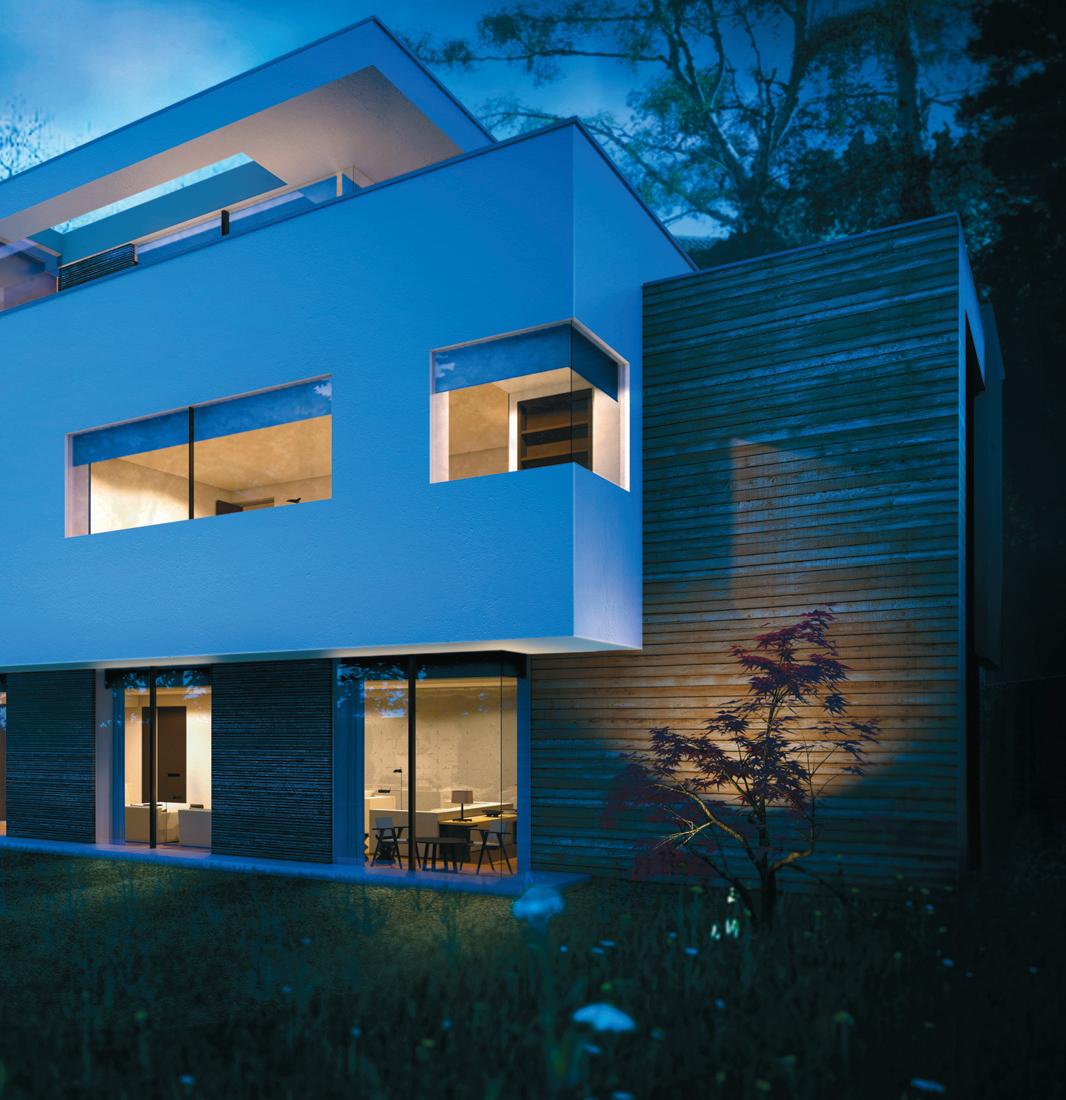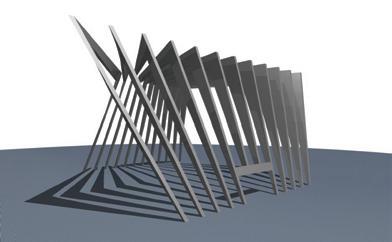
14 minute read
Software ArchiCAD 15
Graphisoft ArchiCAD 15
Last issue AEC reviewed the new renovation tools in the latest release of ArchiCAD from Graphisoft. This month we conclude the review, highlighting the other functional improvements to the popular architectural BIM modelling tool, writes Martyn Day.
As AEC Magazine has reported previously, the interest in Building Information Modelling (BIM) has recently been accelerated thanks to the Government’s construction advisor, Paul Morrell announcing that BIM will be mandated on all Government projects after 2016 with a gentle phasing in over the next five years. This decision has probably brought fear to the firms that specialise in government run education and healthcare but with BIM adoption being fairly low, the majority of the industry will be learning on the job.
While Autodesk has done a good job in marketing Revit as being BIM, the reality is that there are a number of applications that offer similar BIM deliverables, Bentley Architecture and Graphisoft ArchiCAD being two popular choices in the UK.
For those not familiar with ArchiCAD, it is a Hungarian developed architectural 2D and 3D modelling application, which is the most mature BIM solution on the market, having been launched in 1987. I specify architectural because unlike the competing solutions, ArchiCAD focuses its main feature set on the single discipline (although there is an add-on for MEP). Another unique feature is that ArchiCAD runs on both Apple Mac and Windows PCs which, with the rise in popularity of Apple computers, is a clear advantage.
Before diving into the Release 15 features, it is worth mentioning that Graphisoft also recently launched an online design community and mobile communication tool called BIMx for iOS. Using this application it is possible to send models to people using iPads or iPhones who can then explore and remotely walkthrough the 3D designs without having an ArchiCAD license.
The software offers four different rendering engines, gravity, fly mode, individual building element information, distance measuring and presaved walkthroughs. BIMx is included as part of the ArchiCAD 15 trial download.
Graphisoft themes its yearly updates to ArchiCAD like no other vendor. The major two issues addressed in this release were the renovation market and expanding ArchiCAD’s ability to handle complex geometry. In the July/August issue we looked at the effective workflow that had been implemented covering the creation and deletion of elements, clearly showing what was to be demolished and what the new design would be.
With tough market conditions out there for architects, it seems most vendors are adding some
ArchiCAD 15 now offers a range of modelling tools to evaluate complex structures in the early stages of design. Here a progressive frame structure is rendered with shadows.
ArchiCAD 15 now integrates IFC into its core processes. R15’s exceptional renovation details can now be embedded in IFC files for clear co-ordination with other users.
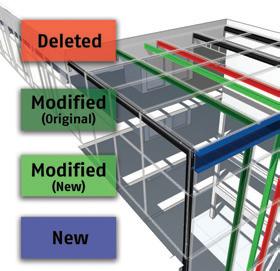
capability in this area, although like its collaboration server technology, Graphisoft has excelled at £540 graphisoft.com
reducing the complexities of use.
Architects continue to look to innovate and create designs using new freeform geometric shapes and structures. Release 15 expands the geometric creative freedom of ArchiCAD and has addressed longstanding issues of user interface when comprehending 3D space and applying workplanes.
Complex geometry
ArchiCAD 15’s key geometry enhancement, the new shell tool, is all about providing design freedom. The shell capability supports three methods: extrude, revolve or ruled. All work in a simple or detailed way allowing quick creation of basic forms or generation
Product Info
Product:
ArchiCAD 15
Supplier:
Graphisoft Price: £3,000 plus mandatory subscription of
Website:
from complex profiles.
The software automatically creates a ‘membrane’ for this structure based on its defining components (core driving geometry). The thickness of the shell can be defined and composite structure can be applied and it will be displayed. These composite definitions can be applied to all shell structures in whichever method was used to create them.
There are a range of other capabilities with shells; such as the ability to alter the base height, apply distortion, flip, grow, rotate, mirror, segment, drag, and morph.
It is possible to define a single contour polygon for a shell in 2D section or elevation that can be used to shape basic geometry into more complex shapes, such as roof elements. This can also be done in 3D, using other elements in a model. It is also possible to create any number of holes within a shell, which can also be easily manipulated. The edges of shells (even holes) can be assigned different materials.
In combination these can be used to create really complex, detailed geometric forms, with intelligent structure information that can be applied to the Information generated for the model.
Many times in BIM tools, complex geometry, like roofs have been defined in products such as McNeel and Associated Rhino and simply imported as dumb geometry, which break the whole concept of BIM.
ArchiCAD 15’s shells also play happily with standard ArchiCAD elements, such as skylights. They can be placed in 2D or in 3D and when they are placed they automatically oriented themselves with the shell and can be moved within the shell body.
The gravity feature of ArchiCAD can also be applied to shells. This means components that are drawn over them will automatically sense the height of the component underneath. A shelled component can be selected as the external or internal surface, enabling the ‘embedding’ of elements, like walls into the shelled structure.
With the introduction of complex shells, ArchiCAD has new intelligent connections, which consolidates previous connections for items such as curtain walls. There is some new naming here too, Trim means a connection that creates association between components (all will update if edited), while cropping will cut a component to another element but without making a direct association (components are independent of editing). There is a new trim elements to roof and/or shell command, allowing for fast modelling with walls and columns.
This release brings substantial new 3D capabilities


Reference lines of elements and guidelines have been considerably improved. Now guidelines are created only when required and with a greater degree of control.
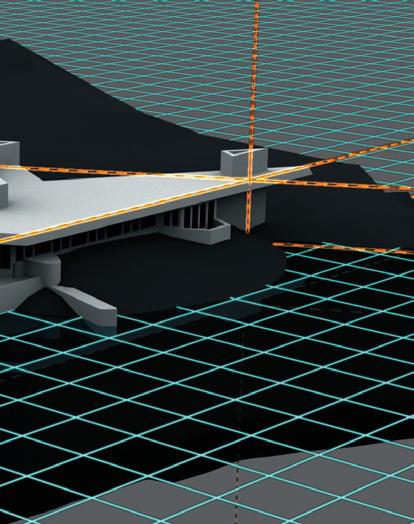
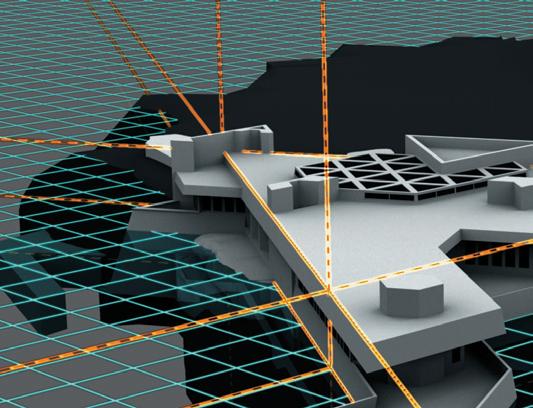
for ArchiCAD and, as usual, have been implemented in a very easy to use manner. Creating complex geometry still requires some thought, although here it is mainly considering which of the many 3D construction methods best fits the shapes required. I understand that the foundation modelling technology for all this is brand new and will possibly enable development of ArchiCAD towards the generative design capability, which is the forte of Bentley’s Generative Components (GC) and Rhino Grasshopper.
Enhancements
ArchiCAD 15 has new blue, auto-orienting Editing Planes, which make element selection and modification much easier. They can be applied to selected components or moved around the 3D space to start the creation of new geometry and support independent grid and snap points.
Using a new dimming effect it is possible to get a better sense of depth in 3D element creation and modification. The creation and placement of reference guidelines have been significantly enhanced aiding both 2D and 3D creation, providing visual feedback.
There are also new GDL parametric libraries of 3D components with some lovely boats, solar cell and heating, wind turbines, shelving units, kitchen appliances and all the other typical household and business items.
EcoDesigner
has been updated for release 15. EcoDesigner, can quickly and easily analyse designs for energy efficiency. Providing invaluable feedback on the building’s performance means the architect can make better decisions on how to conform to regulations and satisfy the interests of the client and the operator of the building.
In release 15, EcoDesigner gets an improved Building Energy Evaluation Report PDF, adding 40% more information versus the previous version. The software also outputs to Excel for a detailed breakdown can now be exported to the Passivhaus energy calculator. Weather data has been improved to include ASHRAE-compliant city data.
Users can now override U/R values to experiment with different material properties, which will be useful in the early design phase.
Open BIM
Graphisoft is probably the biggest supporter of the Industry Foundation Classes (IFC) standard for BIM and has been since its onset. Interoperability is potentially the biggest problem that the construction industry will face as competing BIM systems really
Requirements
System Requirements
OS: Windows XP(32-bit and 64-bit), Windows Vista (32-bit and 64-bit), Windows 7 (32bit and 64-bit) Mac OS X 10.6 Snow Leopard: (Only case insensitive file-system volumes are supported.) 64bit system recommended
Processor
PC: Intel Pentium 4, or compatible processors with equal or higher performance Mac: Macintosh with 64-bit Intel processor (Core2Duo) Multicore processor is recommended to exploit ArchiCAD 15 performance capabilities
Memory
With 64-bit system: 3GB RAM is required, 6GB RAM or more is recommended. With 32-bit system: 2GB RAM is required, 4GB or more is recommended. The maximum amount of memory ArchiCAD can use on a 32-bit system is 4GB.
lack a credible open standard. IFC is all the industry has and it is still playing catch-up.
ArchiCAD 15 has enhanced IFC output; MEP elements can be saved as complex yet lightweight BREPs (boundary representation) geometry, renovation status saved to IFC, ArchiCAD and IFC models can be merged. IFC properties are now native elements in the ArchiCAD database and settings can be edited in the element settings dialogue.
The final point to mention is that this version is native 64-bit on Windows and Mac OS, IFC and BIM server. This means much more memory can be addressed, which means larger models and faster performance.
Conclusion
This is a big and beefy update to ArchiCAD. For existing users who create mainly rectilinear buildings there are speed and feasible benefits to many of the new features despite the concentration on freeform geometry.
Moving to 64-bit to have larger models and address lots of memory is worth it on its own.
The real benefit will be to those designers who have struggled to design shapes that have proved difficult in previous versions, or have had to create dumb geometry to define the surface. With the increasing use of computerised manufacture the cost of producing these free forms is drastically reducing and become more popular.
With ArchiCAD 15, it now has the 3D power to allow much greater freedom in geometric exploration.
Design Viz showcase
From an internationally-celebrated sporting event, to a seat of learning and a long-term domestic build, design visualisation is proving vital in
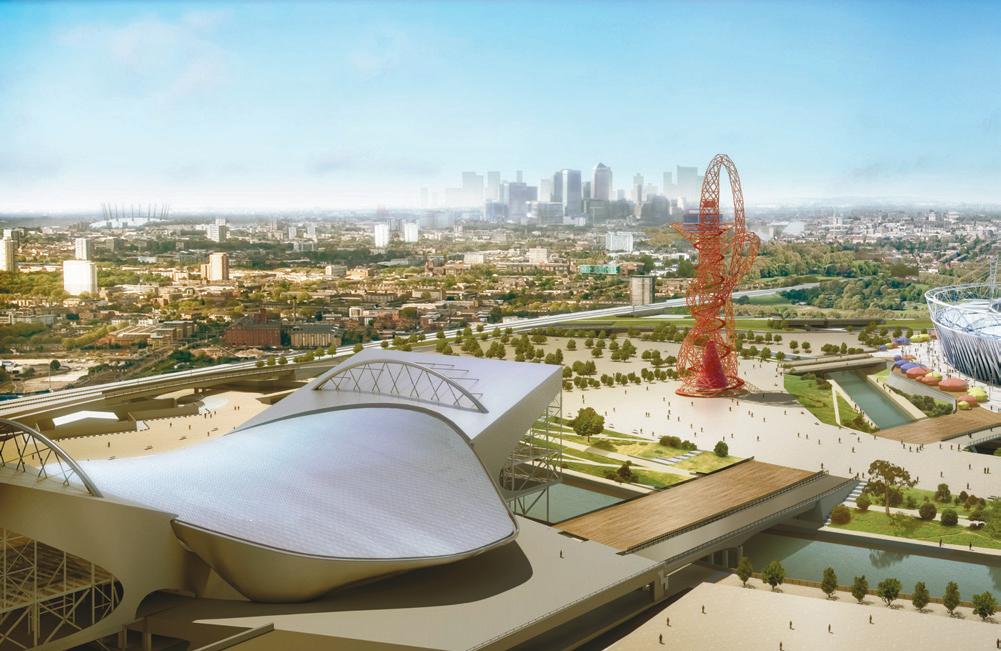
Pembroke College
In a city famous for its educational establishments, Pembroke College has ambitious plans for a spatially complex expansion of its central Oxford campus.
Blink Image was brought in to produce a series of photorealistic images and a walkthrough animation of the proposed new campus, explaining how the project fits around the existing listed buildings and gardens.
The 3D models were created by Blink from the architect’s drawings. “We had drawings for every last design detail, which on the one hand was a real challenge but on the other was really nice to be working to that level of detail,” said Blink Image director Richard Birket.
“Once full resolution snapshots along the animation path had been signed off, we submitted the numerous render jobs — one per camera, both GI pre-passes and full render passes — to our in-house render farm.”
The animation was rendered at 720p and composited using After Effects. Frame render times varied between 10-30 minutes depending on complexity of the shot. Architectural modelling was performed in AutoCAD Architecture, transferring to 3ds max for animation and texture/lighting assignment, before rendering in Vray.
From the architectural plans there was some confusion over the complex use of spaces and different levels, so it became important that the visualisation could unravel that for both a technical and non-technical audience.
Careful use of the orientation model within the animation and visual referencing back to the existing college, with which everyone was familiar, showed the relationships between these buildings.
“We always try to use something new to us in every job that we undertake so that we are always expanding our skill set,” said Mr Birket. “The main ‘special technique’ in this presentation was in the introductory section of the animation where we had the idea of giving the overview/orientation model the appearance of a physical, architectural model sitting on a desk in the bursar’s office. We achieved the miniaturised look through a combination of model-type textures, subtle HDR lighting and shallow depth of field applied as a postproduction process. www.blinkimage.com

every stage of the build process. Designing London’s International Quarter
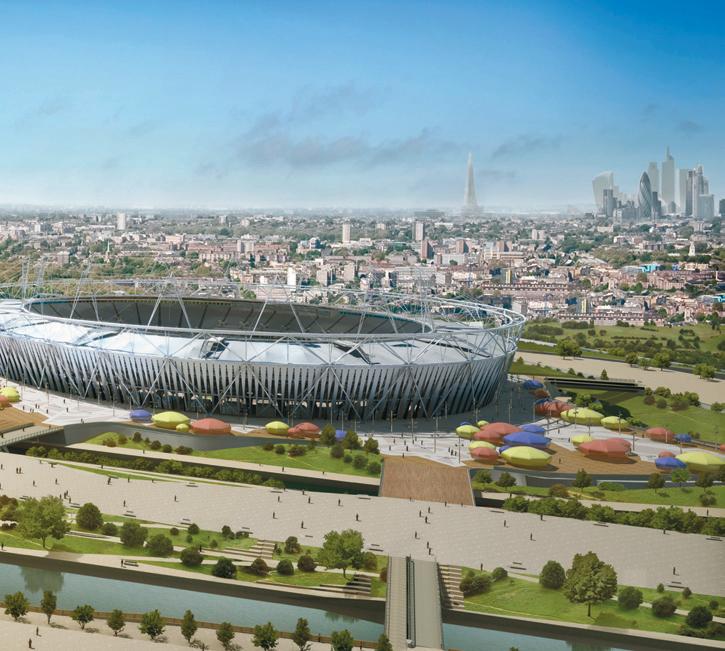
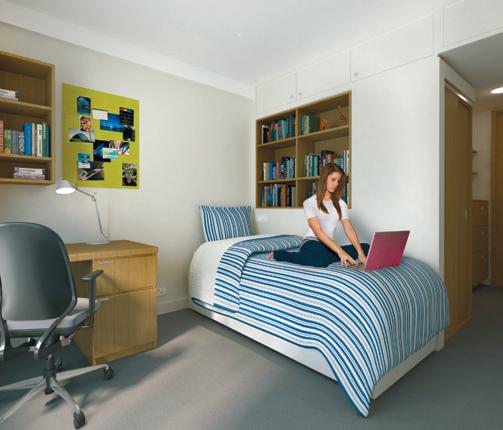
Part of the London 2012 Olympics ethos is to leave a lasting legacy for the area in the east of the city where the world’s greatest sporting event will take place.
In addition to the Athletes’ Village, Olympic Stadium and other sporting venues, the International Quarter is a four million square ft business development that will house Europe’s largest urban shopping centre with 1.9 million square ft of retail and leisure space including bars, restaurants and parkland.
London-based visualisation company Glowfrog Studios took on the task of providing the imagery for the proposed office buildings on the site, while encompassing all the other Olympic site structures that are yet to be completed.
The commission was threefold. The client Lendlease wanted an aerial CGI looking across the Olympic site to Canary Wharf, Greenwich Peninsula and the city; a high-level shot from the top of one of the new corporate buildings with views over the Olympic Park; and a series of panoramic photographs taken at different levels from the location of the proposed building showing views of Olympic Park and the City.
Just to make the brief a little harder, the client provided aerial photography shot into the sun on a hazy January day, all of which was unusable. Glowfrog instead chose to recreate the view entirely in Photoshop, building a collage of photographs, 3D models and digital painting to get the desired effect.
Over four weeks a team of three, including a 3D artist and Photoshop retoucher, worked between Autodesk 3ds Max building models and artistic work using Autodesk Maya to complete the project, before the final renders were done using Mental Ray.
www.glowfrog.com www.lendlease.com
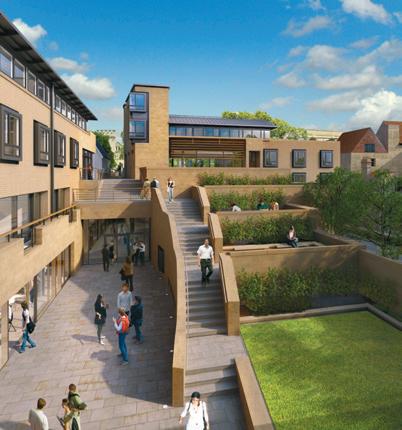
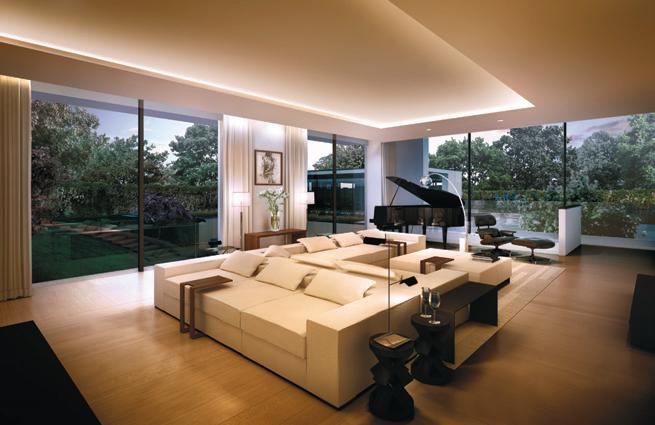
York House
York House is a project that started life in 2008, with a commission for design visualisation specialist Atelier York to produce a few relatively simple exterior renders to better help the architects visualise their design.
A few simple stills and a quick fly-through later and the project was granted planning permission, but the visualisation work did not end there. Four years later (including a client-induced pause) the project has resulted in 15 minutes of animations, including
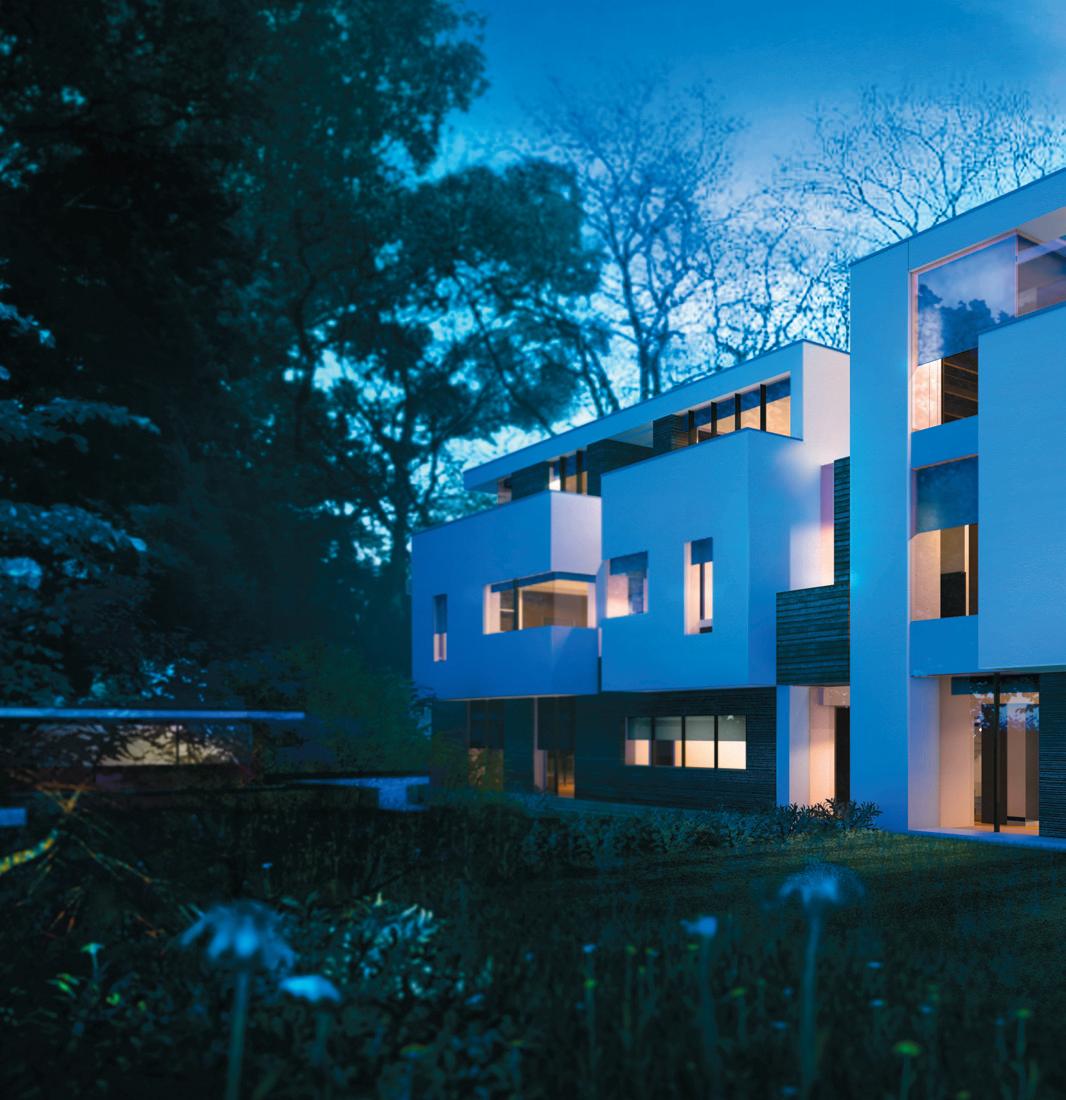
full interior walkthroughs and external fly-arounds, and over 40 still images
“We were supplied with detailed CAD drawings by the architects, including plans, sections, elevations and detail drawings for fixtures and fittings,” says Alex York, architectural artist and founder of Atelier York.
Taking this as the starting point the majority of the modelling was handled by importing the plans, elevations and sections into 3ds max that were then traced using splines, and extruded and tweaked using Editable Poly.
Once the structural geometry was signed off furniture and other detail models were produced, before materials, textures and lighting was applied.
The team of three used a vast combination of Autodesk 3ds max design, mental ray (integrated into 3ds max), Adobe Photoshop, Adobe Lightroom, Autodesk Backburner, Adobe After Effects and Adobe Media Encoder, as well as many plug-ins and scripts for 3ds max (some off-the-shelf and some written in-house to help with common tasks).
Using a photograph-based workflow, with real camera exposure controls to simulate a real lens, photometric spotlights, strip-lights and kelvin values to achieve an accurate and consistent white balance meant some parts needed extra mapping and texture layers. York’s main headache, however, resulted from memory management within mental ray and 3ds max.
“We spent a great deal of time optimising models, texture maps, lights and render settings to keep memory usage down as low as possible and render times as low as possible. With some shots having over 100 pieces of high detail furniture and objects, up to 100 lights and many texture maps, our workstations were under a great deal of pressure.”
“But planning ahead allowed us to maintain a workable level of detail throughout each shot that was not only manageable but cost-effective.”
